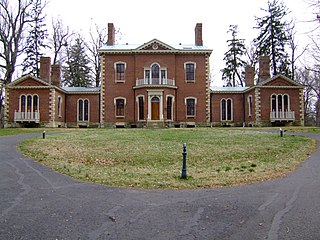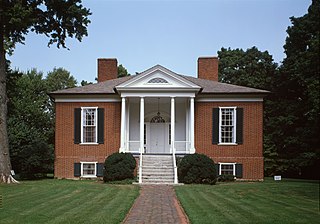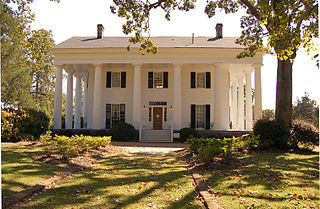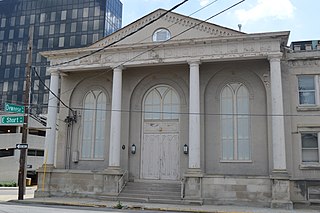
Nicholas County is a county located in the U.S. state of Kentucky. As of the 2020 census, the population was 7,537. Its county seat is Carlisle, which is also the only incorporated community in the county. Founded in 1799, the county is named for Col. George Nicholas, the "Father of the Kentucky Constitution."

Little Dixie is a historic 13- to 17-county region along the Missouri River in central Missouri, United States. Its early Anglo-American settlers were largely migrants from the hemp and tobacco districts of Virginia, Kentucky, and Tennessee. They brought enslaved African Americans with them or purchased them as workers in the region. Because Southerners settled there first, the pre-Civil War culture of the region was similar to that of the Upper South. The area was also known as Boonslick country.

Ashland is the name of the plantation of the 19th-century Kentucky statesman Henry Clay, located in Lexington, Kentucky, in the central Bluegrass region of the state. The buildings were built by enslaved African Americans, and enslaved people grew and harvested hemp, farmed livestock, and cooked and cleaned for the Clays.

Farmington, an 18-acre (7.3 ha) historic site in Louisville, Kentucky, was once the center of a hemp plantation owned by John and Lucy Speed. The 14-room, Federal-style brick plantation house was possibly based on a design by Thomas Jefferson and has several Jeffersonian architectural features. As many as 64 African Americans were enslaved by the Speed family at Farmington.

Boone Hall Plantation is a historic district located in Mount Pleasant, Charleston County, South Carolina, United States and listed on the National Register of Historic Places. The plantation is one of America's oldest plantations still in operation. It has continually produced agricultural crops for over 320 years and is open for public tours.

Bryan Station was an early fortified settlement in Lexington, Kentucky. It was located on present-day Bryan Station Road, about three miles (5 km) northeast of New Circle Road, on the southern bank of Elkhorn Creek near Briar Hill Road. The settlement was established in the spring of 1776 by brothers Morgan, James, William, and Joseph Bryan, and brother-in-law William Grant, all from Yadkin River Valley, Rowan County, North Carolina. After a disastrous winter and attacks by Native Americans, all the Bryan family survivors abandoned the station and returned to the Yadkin River Valley in August 1780. Falling under the command of Elijah Craig, the remaining occupants withstood several American Indian attacks.

The prehistory and history of Kentucky span thousands of years, and have been influenced by the state's diverse geography and central location. Archaeological evidence of human occupation in Kentucky begins approximately 9,500 BCE. A gradual transition began from a hunter-gatherer economy to agriculture c. 1800 BCE. Around 900 CE, the Mississippian culture took root in western and central Kentucky; the Fort Ancient culture appeared in eastern Kentucky. Although they had many similarities, the Fort Ancient culture lacked the Mississippian's distinctive, ceremonial earthen mounds.

Ward Hall is a Greek Revival antebellum plantation mansion located in Georgetown, Kentucky. The main house covers 12,000 square feet (1,100 m2), with 27-foot (8.2 m) high Corinthian fluted columns.

The history of slavery in Kentucky dates from the earliest permanent European settlements in the state, until the end of the Civil War. Kentucky was classified as the Upper South or a border state, and enslaved African Americans represented 24 percent by 1830, but declined to 19.5 percent by 1860 on the eve of the Civil War. The majority of enslaved people in Kentucky were concentrated in the cities of Louisville and Lexington, in the fertile Bluegrass Region as well the Jackson Purchase, both the largest hemp- and tobacco-producing areas in the state. In addition, many enslaved people lived in the Ohio River counties where they were most often used in skilled trades or as house servants. Few people lived in slavery in the mountainous regions of eastern and southeastern Kentucky. Those that did that were held in eastern and southeastern Kentucky served primarily as artisans and service workers in towns.

The Abner Gaines House or Gaines Tavern History Center was built on the Old Lexington Pike in Walton, Kentucky in 1814. It is the oldest house in Walton and is built in the Federal Style, featuring three stairways and ten carved mantels.
Levi Todd was an 18th-century American pioneer who, with his brothers John and Robert Todd, helped found present-day Lexington, Kentucky and were leading prominent landowners and statesmen in the state of Kentucky prior to its admission into the United States in 1792.

Antebellum architecture is the neoclassical architectural style characteristic of the 19th-century Southern United States, especially the Deep South, from after the birth of the United States with the American Revolution, to the start of the American Civil War. Antebellum architecture is especially characterized by Georgian, Neo-classical, and Greek Revival style homes and mansions. These plantation houses were built in the southern American states during roughly the thirty years before the American Civil War; approximately between the 1830s to 1860s.

Ryan Francis Quarles is an American Republican politician who has served as Agriculture Commissioner of Kentucky since 2016. He served in the Kentucky House of Representatives from 2011 to 2016.

First African Baptist Church is a Baptist church at 264-272 E. Short Street in Lexington, Kentucky. The congregation was founded c. 1790 by Peter Durrett and his wife, slaves who came to Kentucky with their master, Rev. Joseph Craig, in 1781 with "The Travelling Church" of Baptists from Spotsylvania, Virginia.
The Thomas Shelby House, also known as Kerr House, is a historic home located near Lexington, Lafayette County, Missouri. It was built circa 1855, and is a two-story, Greek Revival style brick I-house. It has a two-story rear ell with two-story porch. The front facade features an entry portico with tapering octagonal posts and scrollwork balustrade.
Peter Durrett was a Baptist preacher and slave, who with his wife founded the First African Baptist Church of Lexington, Kentucky by 1790. By his death, the congregation totaled nearly 300 persons. It is the first black congregation west of the Allegheny Mountains, the first black Baptist congregation in Kentucky, and the third oldest black congregation in the United States. Its historic church was built in 1856, under the third pastor, and is listed on the National Register of Historic Places.

Linville is a Census-designated place located in Rockingham County, in the U.S. state of Virginia. It is located 6 miles north of Harrisonburg, Virginia. It is for the first time listed as CDP for the United States Census 2020. It contains the Linville United Church of Christ.

Lakeport Plantation is a historic antebellum plantation house located near Lake Village, Arkansas. It was built around 1859 by Lycurgus Johnson with the profits of slave labor. The house was restored between 2003 and 2008 and is now a part of Arkansas State University as a Heritage site museum.
Thomas Lewis was an American Revolutionary War veteran who figured prominently in the early development of Lexington, Kentucky and the Commonwealth of Kentucky. He administered the oath of office to Kentucky's first governor, Isaac Shelby, in 1792.

John Coburn was a Kentucky Pioneer, Circuit Court Judge, and Territory Judge.






















